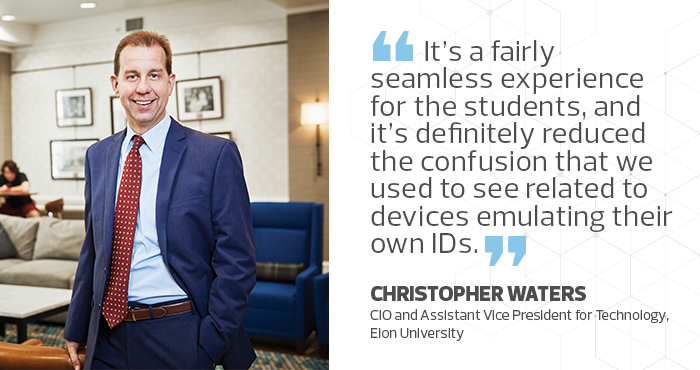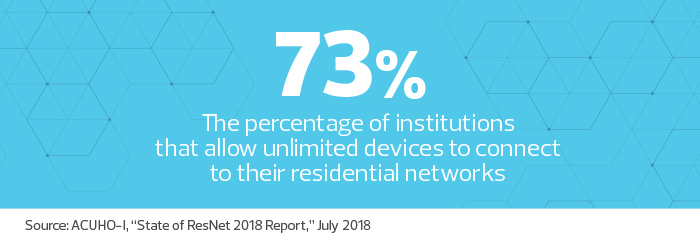Colleges Optimize Traffic on Busy Residence Hall Networks
When students arrived on the Elon University campus this semester, they may have noticed something missing from their dorm rooms.
Ethernet ports, the plastic-framed wall jacks ubiquitous in many residence halls, are now a thing of the past at Elon, a North Carolina university with roughly 7,000 students.
The ports, says Christopher Waters, CIO and assistant vice president for technology, were removed one by one over the past few years after students complained about challenges with wireless access.
“At first, we took a look and it didn’t make any sense, because we had a robust wireless network with plenty of bandwidth,” Waters recalls. “But what we discovered was those ports were part of the problem.” If a student plugged a printer into a wall jack, for example, “it would emulate its own identity, and their neighbor would try to log in to it.”
The situation wasn’t much better on the wireless front. “You would see students setting up their wireless game systems and deciding to name them ‘Elon,’” Waters says. “These actions were causing a lot of confusion. We realized there had to be a better way.”
MORE FROM EDTECH: Check out how universities are expanding wi-fi outside campus buildings!
Universities Install Dual Networks to Boost Network Performance
Elon isn’t the only campus where residence hall networking is a challenge. The Internet of Things, coupled with the increase in students’ devices, is forcing colleges to adapt their IT strategies.
“We’re not just dealing with smartphones and laptops anymore,” says Henry Torres, CIO at Arkansas State University. “Now our students are bringing everything with them — their tablets, their smart TVs, their PS2s — and they want to be able to connect it all immediately.”
Indeed, a 2018 report from the Association of College and University Housing Officers-International cites students’ increased reliance on mobile devices as a factor in colleges increasing both wireless bandwidth in residence halls and efforts to control and optimize bandwidth consumption.

Photography by Geoff Wood.
Just six years ago, according to ACUHO-I, only one quarter of institutions offered at least one gigabyte of bandwidth. Today, 72 percent provide 1GB or more, and nearly a third give students at least 7GB.
“It’s about meeting their academic needs and the work they’re doing online as much as their personal and social needs,” says T.J. Logan, an ACUHO-I spokesman and the associate vice president for student affairs at Temple University. “So, most campuses are now investing in Wi-Fi. It’s just a matter of whether they’re doing so strategically, with a plan for keeping up with students’ needs over time.”
Elon’s approach involved converting residence halls to exclusively wireless and using two separate networks to segregate traffic based on each device’s security needs. One network supports gaming systems, smart devices and the like, and the other is for laptops and academic uses.
That “gadget network,” which runs on Cisco’s Identity Services Engine, requires students to register each device and log in to authenticate as users.
“It’s a fairly seamless experience for the students, and it’s definitely reduced the confusion that we used to see related to devices emulating their own IDs,” Waters says. “It also gives us better visibility into what’s on the network — and it has reduced the tech calls we receive around wireless.”
Make Access Point Management Easier with Central Management
North Carolina State University also improved residence hall connectivity as part of a campuswide wireless upgrade, says Ed Rogers, director of engineering and construction in the communication technologies department. First, staff installed CAT 6 cabling in any residence hall that didn’t already have it.
Then they installed Cisco network switches in each dormitory telecommunications room and, finally, Aruba 205H wireless access points in nearly 4,400 student rooms.
“We’d provided wired connections to each dorm room since the mid-’90s,” Rogers says, “with wireless connections in all the common areas. But the students wanted wireless in their rooms, so they were bringing their own access points with them when they moved in.”
That worked, except for the fact that APs often interfered with each other. Eventually, Rogers says, “we decided we really needed something more robust.”
Now, one large controller on the university’s network manages the APs — for example, controlling power levels and channels to reduce interference, says Rogers. “The result is a much better wireless experience than you’d otherwise have with hundreds of people bringing their own APs.”
MORE FROM EDTECH: Find out what is truth and what is fiction about improving your campus network!
Improve Wireless Networks with the Expectation to Expand
At Arkansas State University, the goal was to build a network that was ready for anything, says Torres.
“We wanted an easy way to monitor network traffic and to provide support to our students as quickly as they needed it,” he says. “But the biggest thing was making sure their rooms feel like home, where they can walk in, connect and do their thing no matter how many devices they want on their network.”
The first challenge, Torres says, involved “getting there at a reasonable cost with a resident population the size of a small city.”
Staff started with a pilot in some of the oldest residence halls, where thick brick walls tended to impair connections. Then, incorporating students’ input, they installed more than 1,300 “intelligent” Aerohive APs to deliver 802.11ac Wave 2 wireless coverage in all campus housing.

“Each student now has their own little network, with unlimited bandwidth 24/7,” Torres says. “They can hook up their computers, stream Netflix, do all the gaming they want to do, and then the ‘intelligence’ kicks in if there’s ever a problem.”
If an AP goes down, for example, the Aerohive system detects the problem, uses neighboring APs to pick up the slack and alerts Torres’s team so it can respond quickly.
Torres says he now feels confident that the residence hall network will be capable of serving students’ needs for a long time to come.
“Is it capable of lasting us five or 10 years? Yes, it is — it’s strong, it’s sturdy. Is it adaptable and scalable? We also believe it is. Will this technology be the last we need to implement? No, it will not.”
Talk to him again in 12 or 24 months, Torres says, as each new round of students shows up on campus hauling their own collections of Wi-Fi-ready devices. “Everything is changing all the time. The only thing we know for sure is they’re going to keep us on our toes.”








